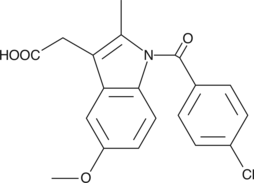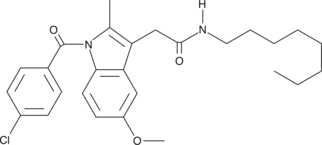Chemicals
Showing 22651–22800 of 41137 results
-
Indole-3-butyric acid (IBA) is a plant hormone of the auxin class that encourages plant growth and root production.{38206,38207} Addition of IBA to rooting medium enhances root formation and improves S. rebaudiana plant survival.{38206} IBA also increases the amount of differentiated tissue and solasodine production by S. elaeagnifolium seedlings in a dose-dependent manner.{38207}
Brand:CaymanSKU:22591 -Out of stock
Indole-3-carbinol (I3C) is a natural phytochemical produced in crucifers by the action of myrosinase on glucobrassinin.{32180} It has been shown to have anti-cancer effects, at least in part through inhibition of NF-κB and Akt signaling pathways.{32182} I3C may undergo a condensation reaction in vivo, leading to the production of 3,3’-diindolylmethane (Item No. 15927), which alters the expression of oncogenes and tumor suppressor genes.{32181}
Brand:CaymanSKU:11325 - 1 gAvailable on backorder
Indole-3-carbinol (I3C) is a natural phytochemical produced in crucifers by the action of myrosinase on glucobrassinin.{32180} It has been shown to have anti-cancer effects, at least in part through inhibition of NF-κB and Akt signaling pathways.{32182} I3C may undergo a condensation reaction in vivo, leading to the production of 3,3’-diindolylmethane (Item No. 15927), which alters the expression of oncogenes and tumor suppressor genes.{32181}
Brand:CaymanSKU:11325 - 10 gAvailable on backorder
Indole-3-carbinol (I3C) is a natural phytochemical produced in crucifers by the action of myrosinase on glucobrassinin.{32180} It has been shown to have anti-cancer effects, at least in part through inhibition of NF-κB and Akt signaling pathways.{32182} I3C may undergo a condensation reaction in vivo, leading to the production of 3,3’-diindolylmethane (Item No. 15927), which alters the expression of oncogenes and tumor suppressor genes.{32181}
Brand:CaymanSKU:11325 - 25 gAvailable on backorder
Indole-3-carbinol (I3C) is a natural phytochemical produced in crucifers by the action of myrosinase on glucobrassinin.{32180} It has been shown to have anti-cancer effects, at least in part through inhibition of NF-κB and Akt signaling pathways.{32182} I3C may undergo a condensation reaction in vivo, leading to the production of 3,3’-diindolylmethane (Item No. 15927), which alters the expression of oncogenes and tumor suppressor genes.{32181}
Brand:CaymanSKU:11325 - 5 gAvailable on backorder
Indole-3-carboxyaldehyde is an active metabolite of tryptophan and a synthetic intermediate.{53935,53936,53937} It is produced by lactobacilli in the gut microbiota via the indole pyruvate pathway, which is catalyzed by aromatic amino acid aminotransferase (ArAT).{53935} Indole-3-carboxyaldehyde (18 mg/kg) increases colonic production of IL-22 and restores colonization resistance to C. albicans infection in a wild-type, but not aryl hydrocarbon receptor knockout (Ahr-/-), mouse model of mucosal candidiasis. It also reduces intestinal mucosal damage in a mouse model of colitis induced by dextran sulfate (DSS; Item No. 23250). Indole-3-carboxaldehyde has been used as a synthetic intermediate in the synthesis of Schiff bases and ergot alkaloids.{53936,53937}
Brand:CaymanSKU:31328 - 10 gAvailable on backorder
Indole-3-carboxyaldehyde is an active metabolite of tryptophan and a synthetic intermediate.{53935,53936,53937} It is produced by lactobacilli in the gut microbiota via the indole pyruvate pathway, which is catalyzed by aromatic amino acid aminotransferase (ArAT).{53935} Indole-3-carboxyaldehyde (18 mg/kg) increases colonic production of IL-22 and restores colonization resistance to C. albicans infection in a wild-type, but not aryl hydrocarbon receptor knockout (Ahr-/-), mouse model of mucosal candidiasis. It also reduces intestinal mucosal damage in a mouse model of colitis induced by dextran sulfate (DSS; Item No. 23250). Indole-3-carboxaldehyde has been used as a synthetic intermediate in the synthesis of Schiff bases and ergot alkaloids.{53936,53937}
Brand:CaymanSKU:31328 - 100 gAvailable on backorder
Indole-3-carboxyaldehyde is an active metabolite of tryptophan and a synthetic intermediate.{53935,53936,53937} It is produced by lactobacilli in the gut microbiota via the indole pyruvate pathway, which is catalyzed by aromatic amino acid aminotransferase (ArAT).{53935} Indole-3-carboxyaldehyde (18 mg/kg) increases colonic production of IL-22 and restores colonization resistance to C. albicans infection in a wild-type, but not aryl hydrocarbon receptor knockout (Ahr-/-), mouse model of mucosal candidiasis. It also reduces intestinal mucosal damage in a mouse model of colitis induced by dextran sulfate (DSS; Item No. 23250). Indole-3-carboxaldehyde has been used as a synthetic intermediate in the synthesis of Schiff bases and ergot alkaloids.{53936,53937}
Brand:CaymanSKU:31328 - 25 gAvailable on backorder
Indole-3-carboxyaldehyde is an active metabolite of tryptophan and a synthetic intermediate.{53935,53936,53937} It is produced by lactobacilli in the gut microbiota via the indole pyruvate pathway, which is catalyzed by aromatic amino acid aminotransferase (ArAT).{53935} Indole-3-carboxyaldehyde (18 mg/kg) increases colonic production of IL-22 and restores colonization resistance to C. albicans infection in a wild-type, but not aryl hydrocarbon receptor knockout (Ahr-/-), mouse model of mucosal candidiasis. It also reduces intestinal mucosal damage in a mouse model of colitis induced by dextran sulfate (DSS; Item No. 23250). Indole-3-carboxaldehyde has been used as a synthetic intermediate in the synthesis of Schiff bases and ergot alkaloids.{53936,53937}
Brand:CaymanSKU:31328 - 50 gAvailable on backorder
Indole-3-carboxylic acid is a plant metabolite derived from tryptophan that has been found in Arabidopsis and has diverse biological activities.{57276,57277,57278,57279} It induces resistance in Arabidopsis against the plant necrotrophic fungus P. cucumerina when applied as a soil-drenching solution at a concentration of 150 µM prior to infection.{57277} Indole-3-carboxylic acid is cytotoxic to A549 human lung and MCF-7 human breast cancer cells (EC50s = 4.6 and 12.9 µg/ml, respectively) and inhibits HIV replication in infected H9 lymphocytes (IC50 = 16.4 µg/ml).{57278} Indole-3-carboxylic acid has also been used as a precursor in the synthesis of substituted thiadiazoles with anticancer activity.{57279}
Brand:CaymanSKU:31166 - 100 gAvailable on backorder
Indole-3-carboxylic acid is a plant metabolite derived from tryptophan that has been found in Arabidopsis and has diverse biological activities.{57276,57277,57278,57279} It induces resistance in Arabidopsis against the plant necrotrophic fungus P. cucumerina when applied as a soil-drenching solution at a concentration of 150 µM prior to infection.{57277} Indole-3-carboxylic acid is cytotoxic to A549 human lung and MCF-7 human breast cancer cells (EC50s = 4.6 and 12.9 µg/ml, respectively) and inhibits HIV replication in infected H9 lymphocytes (IC50 = 16.4 µg/ml).{57278} Indole-3-carboxylic acid has also been used as a precursor in the synthesis of substituted thiadiazoles with anticancer activity.{57279}
Brand:CaymanSKU:31166 - 25 gAvailable on backorder
Indole-3-carboxylic acid is a plant metabolite derived from tryptophan that has been found in Arabidopsis and has diverse biological activities.{57276,57277,57278,57279} It induces resistance in Arabidopsis against the plant necrotrophic fungus P. cucumerina when applied as a soil-drenching solution at a concentration of 150 µM prior to infection.{57277} Indole-3-carboxylic acid is cytotoxic to A549 human lung and MCF-7 human breast cancer cells (EC50s = 4.6 and 12.9 µg/ml, respectively) and inhibits HIV replication in infected H9 lymphocytes (IC50 = 16.4 µg/ml).{57278} Indole-3-carboxylic acid has also been used as a precursor in the synthesis of substituted thiadiazoles with anticancer activity.{57279}
Brand:CaymanSKU:31166 - 250 gAvailable on backorder
Indole-3-carboxylic acid is a plant metabolite derived from tryptophan that has been found in Arabidopsis and has diverse biological activities.{57276,57277,57278,57279} It induces resistance in Arabidopsis against the plant necrotrophic fungus P. cucumerina when applied as a soil-drenching solution at a concentration of 150 µM prior to infection.{57277} Indole-3-carboxylic acid is cytotoxic to A549 human lung and MCF-7 human breast cancer cells (EC50s = 4.6 and 12.9 µg/ml, respectively) and inhibits HIV replication in infected H9 lymphocytes (IC50 = 16.4 µg/ml).{57278} Indole-3-carboxylic acid has also been used as a precursor in the synthesis of substituted thiadiazoles with anticancer activity.{57279}
Brand:CaymanSKU:31166 - 50 gAvailable on backorder
Indole-3-propionic acid is a bacterial metabolite that has antioxidant and neuroprotective activities.{53033,53034,53035} It scavenges ABTS (Item No. 27317) radicals in a cell-free assay when used at concentrations ranging from 50 to 150 µM and decreases hydrogen peroxide-induced malondialdehyde (MDA) levels in rat striatal membranes (IC50 = 180 µM).{53034} Indole-3-propionic acid also decreases increases in MDA levels induced by amyloid β (1-42) (Item No. 20574) in PC12 cells.{53036} It decreases ischemia-induced increases in cell death of pyramidal neurons and levels of 4-hydroxy nonenal (HNE; Item No. 32100) and glial fibrillary acidic protein (GFAP) in the hippocampal CA1 region in gerbils when administered at a dose of 10 mg/kg per day.{53035}
Brand:CaymanSKU:28821 - 10 gAvailable on backorder
Indole-3-propionic acid is a bacterial metabolite that has antioxidant and neuroprotective activities.{53033,53034,53035} It scavenges ABTS (Item No. 27317) radicals in a cell-free assay when used at concentrations ranging from 50 to 150 µM and decreases hydrogen peroxide-induced malondialdehyde (MDA) levels in rat striatal membranes (IC50 = 180 µM).{53034} Indole-3-propionic acid also decreases increases in MDA levels induced by amyloid β (1-42) (Item No. 20574) in PC12 cells.{53036} It decreases ischemia-induced increases in cell death of pyramidal neurons and levels of 4-hydroxy nonenal (HNE; Item No. 32100) and glial fibrillary acidic protein (GFAP) in the hippocampal CA1 region in gerbils when administered at a dose of 10 mg/kg per day.{53035}
Brand:CaymanSKU:28821 - 100 gAvailable on backorder
Indole-3-propionic acid is a bacterial metabolite that has antioxidant and neuroprotective activities.{53033,53034,53035} It scavenges ABTS (Item No. 27317) radicals in a cell-free assay when used at concentrations ranging from 50 to 150 µM and decreases hydrogen peroxide-induced malondialdehyde (MDA) levels in rat striatal membranes (IC50 = 180 µM).{53034} Indole-3-propionic acid also decreases increases in MDA levels induced by amyloid β (1-42) (Item No. 20574) in PC12 cells.{53036} It decreases ischemia-induced increases in cell death of pyramidal neurons and levels of 4-hydroxy nonenal (HNE; Item No. 32100) and glial fibrillary acidic protein (GFAP) in the hippocampal CA1 region in gerbils when administered at a dose of 10 mg/kg per day.{53035}
Brand:CaymanSKU:28821 - 5 gAvailable on backorder
Indole-3-propionic acid is a bacterial metabolite that has antioxidant and neuroprotective activities.{53033,53034,53035} It scavenges ABTS (Item No. 27317) radicals in a cell-free assay when used at concentrations ranging from 50 to 150 µM and decreases hydrogen peroxide-induced malondialdehyde (MDA) levels in rat striatal membranes (IC50 = 180 µM).{53034} Indole-3-propionic acid also decreases increases in MDA levels induced by amyloid β (1-42) (Item No. 20574) in PC12 cells.{53036} It decreases ischemia-induced increases in cell death of pyramidal neurons and levels of 4-hydroxy nonenal (HNE; Item No. 32100) and glial fibrillary acidic protein (GFAP) in the hippocampal CA1 region in gerbils when administered at a dose of 10 mg/kg per day.{53035}
Brand:CaymanSKU:28821 - 50 gAvailable on backorder
Indole-3-pyruvic acid is an endogenous metabolite of tryptophan and intermediate in the biosynthesis of the major auxin hormone, indole-3-acetic acid (IAA; Item No. 16954), in plants.{52871,52872,52873} Indole-3-pyruvic acid (50 and 250 µM) activates the aryl hydrocarbon receptor (AhR) in a reporter assay.{52871} It reduces UVB-induced cytotoxicity and the levels of COX-2 in HaCaT keratinocytes.{52874} Topical administration of indole-3-pyruvic acid (100 µmol) reduces the severity of UVB-induced damage in mouse skin. Dietary administration of indole-3-pyruvic acid (0.1%) reduces diarrhea, colonic inflammation, and the colonic expression of Il1b, Ifng, Tnfa, and Il12b in a mouse model of T cell-mediated colitis.{52871} It increases the time spent in the open arms of the elevated plus maze in mice when administered at a dose of 100 mg/kg.{52872} It also reverses the anxiogenic effect of caffeine (Item No. 14118) and 3-hydroxy kynurenine, but not pentylenetetrazole (Item No. 18682) or phenylethylamine, in the elevated plus maze in mice.
Brand:CaymanSKU:29876 - 1 gAvailable on backorder
Indole-3-pyruvic acid is an endogenous metabolite of tryptophan and intermediate in the biosynthesis of the major auxin hormone, indole-3-acetic acid (IAA; Item No. 16954), in plants.{52871,52872,52873} Indole-3-pyruvic acid (50 and 250 µM) activates the aryl hydrocarbon receptor (AhR) in a reporter assay.{52871} It reduces UVB-induced cytotoxicity and the levels of COX-2 in HaCaT keratinocytes.{52874} Topical administration of indole-3-pyruvic acid (100 µmol) reduces the severity of UVB-induced damage in mouse skin. Dietary administration of indole-3-pyruvic acid (0.1%) reduces diarrhea, colonic inflammation, and the colonic expression of Il1b, Ifng, Tnfa, and Il12b in a mouse model of T cell-mediated colitis.{52871} It increases the time spent in the open arms of the elevated plus maze in mice when administered at a dose of 100 mg/kg.{52872} It also reverses the anxiogenic effect of caffeine (Item No. 14118) and 3-hydroxy kynurenine, but not pentylenetetrazole (Item No. 18682) or phenylethylamine, in the elevated plus maze in mice.
Brand:CaymanSKU:29876 - 250 mgAvailable on backorder
Indole-3-pyruvic acid is an endogenous metabolite of tryptophan and intermediate in the biosynthesis of the major auxin hormone, indole-3-acetic acid (IAA; Item No. 16954), in plants.{52871,52872,52873} Indole-3-pyruvic acid (50 and 250 µM) activates the aryl hydrocarbon receptor (AhR) in a reporter assay.{52871} It reduces UVB-induced cytotoxicity and the levels of COX-2 in HaCaT keratinocytes.{52874} Topical administration of indole-3-pyruvic acid (100 µmol) reduces the severity of UVB-induced damage in mouse skin. Dietary administration of indole-3-pyruvic acid (0.1%) reduces diarrhea, colonic inflammation, and the colonic expression of Il1b, Ifng, Tnfa, and Il12b in a mouse model of T cell-mediated colitis.{52871} It increases the time spent in the open arms of the elevated plus maze in mice when administered at a dose of 100 mg/kg.{52872} It also reverses the anxiogenic effect of caffeine (Item No. 14118) and 3-hydroxy kynurenine, but not pentylenetetrazole (Item No. 18682) or phenylethylamine, in the elevated plus maze in mice.
Brand:CaymanSKU:29876 - 500 mgAvailable on backorder
Brand:CaymanSKU:11065 - 1 gAvailable on backorder
Brand:CaymanSKU:11065 - 250 mgAvailable on backorder
Brand:CaymanSKU:11065 - 500 mgAvailable on backorder
Indolmycin is an antibiotic isolated from various Streptomyces strains that functions by competitively inhibiting the prokaryotic tryptophanyl-tRNA synthetase (IC50 = 30 μM) without significantly affecting the corresponding eukaryotic synthetase.{24924,24923} It exhibits antibacterial activity against mupirocin- and fusidic acid-resistant strains of Staphylococci.{24922}
Brand:CaymanSKU:-Indolmycin is an antibiotic isolated from various Streptomyces strains that functions by competitively inhibiting the prokaryotic tryptophanyl-tRNA synthetase (IC50 = 30 μM) without significantly affecting the corresponding eukaryotic synthetase.{24924,24923} It exhibits antibacterial activity against mupirocin- and fusidic acid-resistant strains of Staphylococci.{24922}
Brand:CaymanSKU:-Indomethacin is a non-selective COX inhibitor (IC50s = 1.67 and 24.6 µM for human COX-1 and COX-2, respectively).{1286} It reduces filter paper-disc induced growth of granulation tissue, a marker of inflammation, in chick chorioallantoic membranes.{37630} Indomethacin reduces ocular inflammation induced by bovine serum in rabbits.{37631} It also reduces paw edema in a rat model of carrageenan-induced inflammation.{37632}
Brand:CaymanSKU:70270 - 1 gAvailable on backorder
Indomethacin is a potent but non-selective inhibitor of both COX-1 and COX-2 in sheep and humans.{1286} Structurally, indomethacin is a substituted indole acetic acid, wherein the carboxylate can be derivatized as an ester or amide. These derivatives show enhanced selectivity for the COX-2 isoform. For example, the IC50 for indomethacin heptyl ester for the inhibition of human recombinant COX-2 is 0.04 µM, making it more than 1,700 times more potent as an inhibitor of COX-2 than COX-1.{8243} While indomethacin itself has an IC50 of 0.05 µM for the inhibition of COX-2, it also inhibits COX-1 with a corresponding IC50 of 0.67 µM.{8243}
Brand:CaymanSKU:70271 - 1 mgAvailable on backorder
Indomethacin is a potent but non-selective inhibitor of both COX-1 and COX-2 in sheep and humans.{1286} Structurally, indomethacin is a substituted indole acetic acid, wherein the carboxylate can be derivatized as an ester or amide. These derivatives show enhanced selectivity for the COX-2 isoform. For example, the IC50 for indomethacin heptyl ester for the inhibition of human recombinant COX-2 is 0.04 µM, making it more than 1,700 times more potent as an inhibitor of COX-2 than COX-1.{8243} While indomethacin itself has an IC50 of 0.05 µM for the inhibition of COX-2, it also inhibits COX-1 with a corresponding IC50 of 0.67 µM.{8243}
Brand:CaymanSKU:70271 - 10 mgAvailable on backorder
Indomethacin is a potent but non-selective inhibitor of both COX-1 and COX-2 in sheep and humans.{1286} Structurally, indomethacin is a substituted indole acetic acid, wherein the carboxylate can be derivatized as an ester or amide. These derivatives show enhanced selectivity for the COX-2 isoform. For example, the IC50 for indomethacin heptyl ester for the inhibition of human recombinant COX-2 is 0.04 µM, making it more than 1,700 times more potent as an inhibitor of COX-2 than COX-1.{8243} While indomethacin itself has an IC50 of 0.05 µM for the inhibition of COX-2, it also inhibits COX-1 with a corresponding IC50 of 0.67 µM.{8243}
Brand:CaymanSKU:70271 - 5 mgAvailable on backorder
Indomethacin is a potent but non-selective inhibitor of both COX-1 and COX-2 in sheep and humans.{1286} Structurally, indomethacin is a substituted indole acetic acid, wherein the carboxylate can be derivatized as an ester or amide. These derivatives show enhanced selectivity for the COX-2 isoform. For example, the IC50 for indomethacin heptyl ester for the inhibition of human recombinant COX-2 is 0.04 µM, making it more than 1,700 times more potent as an inhibitor of COX-2 than COX-1.{8243} While indomethacin itself has an IC50 of 0.05 µM for the inhibition of COX-2, it also inhibits COX-1 with a corresponding IC50 of 0.67 µM.{8243}
Brand:CaymanSKU:70271 - 50 mgAvailable on backorder
Indomethacin is a potent but non-selective inhibitor of both COX-1 and COX-2 in sheep and humans.{1286} Structurally, indomethacin is a substituted indole acetic acid, wherein the carboxylate can be derivitized as an ester or amide. These derivatives show enhanced selectivity for the COX-2 isoform. For example, the IC50 values of indomethacin N-octyl amide for the inhibition of ovine COX-1 and human recombinant COX-2 are 66 µM and 40 nM, respectively, making it 1,650 times more potent as an inhibitor of COX-2 than COX-1.{8243} While indomethacin itself has an IC50 of 0.05 µM for the inhibition of COX-2, it also inhibits COX-1 with a corresponding IC50 of 0.67 µM.
Brand:CaymanSKU:70273 - 1 mgAvailable on backorder
Indomethacin is a potent but non-selective inhibitor of both COX-1 and COX-2 in sheep and humans.{1286} Structurally, indomethacin is a substituted indole acetic acid, wherein the carboxylate can be derivitized as an ester or amide. These derivatives show enhanced selectivity for the COX-2 isoform. For example, the IC50 values of indomethacin N-octyl amide for the inhibition of ovine COX-1 and human recombinant COX-2 are 66 µM and 40 nM, respectively, making it 1,650 times more potent as an inhibitor of COX-2 than COX-1.{8243} While indomethacin itself has an IC50 of 0.05 µM for the inhibition of COX-2, it also inhibits COX-1 with a corresponding IC50 of 0.67 µM.
Brand:CaymanSKU:70273 - 10 mgAvailable on backorder
Indomethacin is a potent but non-selective inhibitor of both COX-1 and COX-2 in sheep and humans.{1286} Structurally, indomethacin is a substituted indole acetic acid, wherein the carboxylate can be derivitized as an ester or amide. These derivatives show enhanced selectivity for the COX-2 isoform. For example, the IC50 values of indomethacin N-octyl amide for the inhibition of ovine COX-1 and human recombinant COX-2 are 66 µM and 40 nM, respectively, making it 1,650 times more potent as an inhibitor of COX-2 than COX-1.{8243} While indomethacin itself has an IC50 of 0.05 µM for the inhibition of COX-2, it also inhibits COX-1 with a corresponding IC50 of 0.67 µM.
Brand:CaymanSKU:70273 - 5 mgAvailable on backorder
Indomethacin is a potent but non-selective inhibitor of both COX-1 and COX-2 in sheep and humans.{1286} Structurally, indomethacin is a substituted indole acetic acid, wherein the carboxylate can be derivitized as an ester or amide. These derivatives show enhanced selectivity for the COX-2 isoform. For example, the IC50 values of indomethacin N-octyl amide for the inhibition of ovine COX-1 and human recombinant COX-2 are 66 µM and 40 nM, respectively, making it 1,650 times more potent as an inhibitor of COX-2 than COX-1.{8243} While indomethacin itself has an IC50 of 0.05 µM for the inhibition of COX-2, it also inhibits COX-1 with a corresponding IC50 of 0.67 µM.
Brand:CaymanSKU:70273 - 50 mgAvailable on backorder
Indomethacin-d4 is intended for use as an internal standard for the quantification of indomethacin (Item No. 70270) by GC- or LC-MS. Indomethacin is a non-selective COX inhibitor (IC50s = 1.67 and 24.6 µM for human COX-1 and COX-2, respectively).{1286} It reduces filter paper-disc induced growth of granulation tissue, a marker of inflammation, in chick chorioallantoic membranes.{37630} Indomethacin reduces ocular inflammation induced by bovine serum in rabbits.{37631} It also reduces paw edema in a rat model of carrageenan-induced inflammation.{37632}
Brand:CaymanSKU:25434 - 1 mgAvailable on backorder
Indomethacin-d4 is intended for use as an internal standard for the quantification of indomethacin (Item No. 70270) by GC- or LC-MS. Indomethacin is a non-selective COX inhibitor (IC50s = 1.67 and 24.6 µM for human COX-1 and COX-2, respectively).{1286} It reduces filter paper-disc induced growth of granulation tissue, a marker of inflammation, in chick chorioallantoic membranes.{37630} Indomethacin reduces ocular inflammation induced by bovine serum in rabbits.{37631} It also reduces paw edema in a rat model of carrageenan-induced inflammation.{37632}
Brand:CaymanSKU:25434 - 500 µgAvailable on backorder
Indoxyl sulfate is a metabolite of tryptophan derived from dietary protein. Tryptophan is metabolized by intestinal bacteria into indole, which is absorbed into the blood and then further metabolized to indoxyl sulfate in the liver, which is normally excreted in urine. In chronic kidney disease patients where renal function is compromised, indoxyl sulfate can accumulate in serum as a uremic toxin, inducing oxidative stress and accelerating progression of the disease.{27740} Indoxyl sulfate at 250 µM can induce the activation of NF-κB, promoting the expression of both TGF-β1 and Smad3 expression in proximal tubular cells of rats, which is associated with profibrotic activity.{26427}
Brand:CaymanSKU:-Out of stock
Indoxyl sulfate is a metabolite of tryptophan derived from dietary protein. Tryptophan is metabolized by intestinal bacteria into indole, which is absorbed into the blood and then further metabolized to indoxyl sulfate in the liver, which is normally excreted in urine. In chronic kidney disease patients where renal function is compromised, indoxyl sulfate can accumulate in serum as a uremic toxin, inducing oxidative stress and accelerating progression of the disease.{27740} Indoxyl sulfate at 250 µM can induce the activation of NF-κB, promoting the expression of both TGF-β1 and Smad3 expression in proximal tubular cells of rats, which is associated with profibrotic activity.{26427}
Brand:CaymanSKU:-Out of stock
Indoxyl sulfate is a metabolite of tryptophan derived from dietary protein. Tryptophan is metabolized by intestinal bacteria into indole, which is absorbed into the blood and then further metabolized to indoxyl sulfate in the liver, which is normally excreted in urine. In chronic kidney disease patients where renal function is compromised, indoxyl sulfate can accumulate in serum as a uremic toxin, inducing oxidative stress and accelerating progression of the disease.{27740} Indoxyl sulfate at 250 µM can induce the activation of NF-κB, promoting the expression of both TGF-β1 and Smad3 expression in proximal tubular cells of rats, which is associated with profibrotic activity.{26427}
Brand:CaymanSKU:-Out of stock
Indoxyl sulfate is a metabolite of tryptophan derived from dietary protein. Tryptophan is metabolized by intestinal bacteria into indole, which is absorbed into the blood and then further metabolized to indoxyl sulfate in the liver, which is normally excreted in urine. In chronic kidney disease patients where renal function is compromised, indoxyl sulfate can accumulate in serum as a uremic toxin, inducing oxidative stress and accelerating progression of the disease.{27740} Indoxyl sulfate at 250 µM can induce the activation of NF-κB, promoting the expression of both TGF-β1 and Smad3 expression in proximal tubular cells of rats, which is associated with profibrotic activity.{26427}
Brand:CaymanSKU:-Out of stock
INDY is an ATP-competitive inhibitor of dual-specificity tyrosine-(Y)-phosphorylation regulated kinase 1A (DYRK1A; Ki = 180 nM; IC50 = 240 nM).{38762} It is selective for DYRK1A over monoamine oxidase (MAO) A and B at concentrations up to 100 μM. INDY inhibits DYRK1A phosphorylation of tau in COS-7 cells expressing EGFP-DYRK1A and EGFP-tau in a concentration-dependent manner. It also restores signaling through nuclear factory of activated T cells (NFAT) and NFAT-dependent transcription in HEK293 cells overexpressing DYRK1A. In vivo, INDY reverses developmental deformities induced by DYRK1A overexpression in X. laevis embryos. INDY also induces proliferation of human and rat β-cells and increases insulin secretion by human islets in vitro.{38763}
Brand:CaymanSKU:23895 - 1 mgAvailable on backorder
INDY is an ATP-competitive inhibitor of dual-specificity tyrosine-(Y)-phosphorylation regulated kinase 1A (DYRK1A; Ki = 180 nM; IC50 = 240 nM).{38762} It is selective for DYRK1A over monoamine oxidase (MAO) A and B at concentrations up to 100 μM. INDY inhibits DYRK1A phosphorylation of tau in COS-7 cells expressing EGFP-DYRK1A and EGFP-tau in a concentration-dependent manner. It also restores signaling through nuclear factory of activated T cells (NFAT) and NFAT-dependent transcription in HEK293 cells overexpressing DYRK1A. In vivo, INDY reverses developmental deformities induced by DYRK1A overexpression in X. laevis embryos. INDY also induces proliferation of human and rat β-cells and increases insulin secretion by human islets in vitro.{38763}
Brand:CaymanSKU:23895 - 10 mgAvailable on backorder
INDY is an ATP-competitive inhibitor of dual-specificity tyrosine-(Y)-phosphorylation regulated kinase 1A (DYRK1A; Ki = 180 nM; IC50 = 240 nM).{38762} It is selective for DYRK1A over monoamine oxidase (MAO) A and B at concentrations up to 100 μM. INDY inhibits DYRK1A phosphorylation of tau in COS-7 cells expressing EGFP-DYRK1A and EGFP-tau in a concentration-dependent manner. It also restores signaling through nuclear factory of activated T cells (NFAT) and NFAT-dependent transcription in HEK293 cells overexpressing DYRK1A. In vivo, INDY reverses developmental deformities induced by DYRK1A overexpression in X. laevis embryos. INDY also induces proliferation of human and rat β-cells and increases insulin secretion by human islets in vitro.{38763}
Brand:CaymanSKU:23895 - 25 mgAvailable on backorder
INDY is an ATP-competitive inhibitor of dual-specificity tyrosine-(Y)-phosphorylation regulated kinase 1A (DYRK1A; Ki = 180 nM; IC50 = 240 nM).{38762} It is selective for DYRK1A over monoamine oxidase (MAO) A and B at concentrations up to 100 μM. INDY inhibits DYRK1A phosphorylation of tau in COS-7 cells expressing EGFP-DYRK1A and EGFP-tau in a concentration-dependent manner. It also restores signaling through nuclear factory of activated T cells (NFAT) and NFAT-dependent transcription in HEK293 cells overexpressing DYRK1A. In vivo, INDY reverses developmental deformities induced by DYRK1A overexpression in X. laevis embryos. INDY also induces proliferation of human and rat β-cells and increases insulin secretion by human islets in vitro.{38763}
Brand:CaymanSKU:23895 - 5 mgAvailable on backorder
INF39 is an irreversible inhibitor of the NLRP3 inflammasome.{46402} INF39 (10 µM) inhibits activation of caspase-1 and the release of IL-1β and lactate dehydrogenase (LDH) induced by ATP (Item No. 14498) or nigericin (Item No. 11437) in LPS-primed bone marrow-derived macrophages (BMDMs). It reduces ATP-induced pyroptosis in LPS-primed THP-1 cells by 33.6% when used at a concentration of 10 µM. INF39 (12.5, 25, and 50 mg/kg) prevents increases in IL-1β protein levels induced by dinitrobenzene sulfonic acid (DNBS) in the colon in a rat model of colitis. It reduces the severity of pancreatic lesions and serum levels of IL-1β, TNF-α, and IL-6 during caerulein- and LPS-induced pancreatitis in mice when administered at doses of 25 and 50 mg/kg.{46403}
Brand:CaymanSKU:28476 - 10 mgAvailable on backorder
INF39 is an irreversible inhibitor of the NLRP3 inflammasome.{46402} INF39 (10 µM) inhibits activation of caspase-1 and the release of IL-1β and lactate dehydrogenase (LDH) induced by ATP (Item No. 14498) or nigericin (Item No. 11437) in LPS-primed bone marrow-derived macrophages (BMDMs). It reduces ATP-induced pyroptosis in LPS-primed THP-1 cells by 33.6% when used at a concentration of 10 µM. INF39 (12.5, 25, and 50 mg/kg) prevents increases in IL-1β protein levels induced by dinitrobenzene sulfonic acid (DNBS) in the colon in a rat model of colitis. It reduces the severity of pancreatic lesions and serum levels of IL-1β, TNF-α, and IL-6 during caerulein- and LPS-induced pancreatitis in mice when administered at doses of 25 and 50 mg/kg.{46403}
Brand:CaymanSKU:28476 - 25 mgAvailable on backorder
INF39 is an irreversible inhibitor of the NLRP3 inflammasome.{46402} INF39 (10 µM) inhibits activation of caspase-1 and the release of IL-1β and lactate dehydrogenase (LDH) induced by ATP (Item No. 14498) or nigericin (Item No. 11437) in LPS-primed bone marrow-derived macrophages (BMDMs). It reduces ATP-induced pyroptosis in LPS-primed THP-1 cells by 33.6% when used at a concentration of 10 µM. INF39 (12.5, 25, and 50 mg/kg) prevents increases in IL-1β protein levels induced by dinitrobenzene sulfonic acid (DNBS) in the colon in a rat model of colitis. It reduces the severity of pancreatic lesions and serum levels of IL-1β, TNF-α, and IL-6 during caerulein- and LPS-induced pancreatitis in mice when administered at doses of 25 and 50 mg/kg.{46403}
Brand:CaymanSKU:28476 - 5 mgAvailable on backorder
Inflachromene is an anti-inflammatory agent that directly binds high mobility group protein 1 (HMGB1) and HMGB2 and reduces their cytoplasmic accumulation in microglial cells.{27536} It is functional in vivo, downregulating proinflammatory functions of HMGB proteins and reducing neuronal damage.{27536} Inflachromene also ameliorates inflammatory pathogenesis in a mouse model of sepsis.{33796}
Brand:CaymanSKU:-Out of stock
Inflachromene is an anti-inflammatory agent that directly binds high mobility group protein 1 (HMGB1) and HMGB2 and reduces their cytoplasmic accumulation in microglial cells.{27536} It is functional in vivo, downregulating proinflammatory functions of HMGB proteins and reducing neuronal damage.{27536} Inflachromene also ameliorates inflammatory pathogenesis in a mouse model of sepsis.{33796}
Brand:CaymanSKU:-Out of stock
Inflachromene is an anti-inflammatory agent that directly binds high mobility group protein 1 (HMGB1) and HMGB2 and reduces their cytoplasmic accumulation in microglial cells.{27536} It is functional in vivo, downregulating proinflammatory functions of HMGB proteins and reducing neuronal damage.{27536} Inflachromene also ameliorates inflammatory pathogenesis in a mouse model of sepsis.{33796}
Brand:CaymanSKU:-Out of stock
Ingenol is a diterpenoid related to phorbol, derived from the milkweed plant E. peplus.{771} It is a protein kinase C activator that displays a Ki value of 30 μM and an ED50 value of 27 μM in vitro.{23438,23437} Most ingenol esters are tumor-promoting.{17808} However, ingenol mebutate possesses anti-tumor activity when used topically for actinic keratosis.{21836}
Brand:CaymanSKU:-Ingenol is a diterpenoid related to phorbol, derived from the milkweed plant E. peplus.{771} It is a protein kinase C activator that displays a Ki value of 30 μM and an ED50 value of 27 μM in vitro.{23438,23437} Most ingenol esters are tumor-promoting.{17808} However, ingenol mebutate possesses anti-tumor activity when used topically for actinic keratosis.{21836}
Brand:CaymanSKU:-Ingenol is a diterpenoid related to phorbol, derived from the milkweed plant E. peplus.{771} It is a protein kinase C activator that displays a Ki value of 30 μM and an ED50 value of 27 μM in vitro.{23438,23437} Most ingenol esters are tumor-promoting.{17808} However, ingenol mebutate possesses anti-tumor activity when used topically for actinic keratosis.{21836}
Brand:CaymanSKU:-Ingenol is a diterpenoid related to phorbol, derived from the milkweed plant E. peplus.{771} It is a protein kinase C activator that displays a Ki value of 30 μM and an ED50 value of 27 μM in vitro.{23438,23437} Most ingenol esters are tumor-promoting.{17808} However, ingenol mebutate possesses anti-tumor activity when used topically for actinic keratosis.{21836}
Brand:CaymanSKU:-Ingenol-3-angelate is a hydrophobic diterpene ester that can be isolated from the euphorb E. peplus. It rapidly induces cell death in proliferating keratinocytes through plasma membrane and mitochondrial disruption, although it can also initiate apoptosis in some cancer cell lines (LD90 = ~190 µM).{26474} Secondarily, ingenol-3-angelate causes inflammation due, at least in part, to activation of PKC, leading to antibody-dependent cellular cytotoxicity.{26475,26472,23438} These actions have relevance in diminishing actinic keratosis and, possibly, other cancers of the skin.{21836,26473}
Brand:CaymanSKU:-Ingenol-3-angelate is a hydrophobic diterpene ester that can be isolated from the euphorb E. peplus. It rapidly induces cell death in proliferating keratinocytes through plasma membrane and mitochondrial disruption, although it can also initiate apoptosis in some cancer cell lines (LD90 = ~190 µM).{26474} Secondarily, ingenol-3-angelate causes inflammation due, at least in part, to activation of PKC, leading to antibody-dependent cellular cytotoxicity.{26475,26472,23438} These actions have relevance in diminishing actinic keratosis and, possibly, other cancers of the skin.{21836,26473}
Brand:CaymanSKU:-Ingenol-3-angelate is a hydrophobic diterpene ester that can be isolated from the euphorb E. peplus. It rapidly induces cell death in proliferating keratinocytes through plasma membrane and mitochondrial disruption, although it can also initiate apoptosis in some cancer cell lines (LD90 = ~190 µM).{26474} Secondarily, ingenol-3-angelate causes inflammation due, at least in part, to activation of PKC, leading to antibody-dependent cellular cytotoxicity.{26475,26472,23438} These actions have relevance in diminishing actinic keratosis and, possibly, other cancers of the skin.{21836,26473}
Brand:CaymanSKU:-Ingenol-3-angelate is a hydrophobic diterpene ester that can be isolated from the euphorb E. peplus. It rapidly induces cell death in proliferating keratinocytes through plasma membrane and mitochondrial disruption, although it can also initiate apoptosis in some cancer cell lines (LD90 = ~190 µM).{26474} Secondarily, ingenol-3-angelate causes inflammation due, at least in part, to activation of PKC, leading to antibody-dependent cellular cytotoxicity.{26475,26472,23438} These actions have relevance in diminishing actinic keratosis and, possibly, other cancers of the skin.{21836,26473}
Brand:CaymanSKU:-INH1 is an inhibitor of the interaction between the oncogene high expression in cancer 1 (Hec1) and its regulator, the serine/threonine kinase Nek2.{48794} It binds to Hec1 and reduces Nek2 protein levels in HeLa cells when used at a concentration of 25 µM. INH1 inhibits the growth of MDA-MB-468, SK-BR-3, T47D, MDA-MB-361, ZR-75-1, HBL-100, MDA-MB-435, and Hs 578T breast cancer cells (GI50s = 10.5-20.5 µM). It inhibits migration of MDA-MB-231 cells in a transwell migration assay (IC50 = 176 nM).{48795} INH1 (50 and 100 mg/kg) reduces tumor growth in an MDA-MB-468 mouse xenograft model.{48794}
Brand:CaymanSKU:29015 - 10 mgAvailable on backorder
INH1 is an inhibitor of the interaction between the oncogene high expression in cancer 1 (Hec1) and its regulator, the serine/threonine kinase Nek2.{48794} It binds to Hec1 and reduces Nek2 protein levels in HeLa cells when used at a concentration of 25 µM. INH1 inhibits the growth of MDA-MB-468, SK-BR-3, T47D, MDA-MB-361, ZR-75-1, HBL-100, MDA-MB-435, and Hs 578T breast cancer cells (GI50s = 10.5-20.5 µM). It inhibits migration of MDA-MB-231 cells in a transwell migration assay (IC50 = 176 nM).{48795} INH1 (50 and 100 mg/kg) reduces tumor growth in an MDA-MB-468 mouse xenograft model.{48794}
Brand:CaymanSKU:29015 - 25 mgAvailable on backorder
INH1 is an inhibitor of the interaction between the oncogene high expression in cancer 1 (Hec1) and its regulator, the serine/threonine kinase Nek2.{48794} It binds to Hec1 and reduces Nek2 protein levels in HeLa cells when used at a concentration of 25 µM. INH1 inhibits the growth of MDA-MB-468, SK-BR-3, T47D, MDA-MB-361, ZR-75-1, HBL-100, MDA-MB-435, and Hs 578T breast cancer cells (GI50s = 10.5-20.5 µM). It inhibits migration of MDA-MB-231 cells in a transwell migration assay (IC50 = 176 nM).{48795} INH1 (50 and 100 mg/kg) reduces tumor growth in an MDA-MB-468 mouse xenograft model.{48794}
Brand:CaymanSKU:29015 - 5 mgAvailable on backorder
INH1 is an inhibitor of the interaction between the oncogene high expression in cancer 1 (Hec1) and its regulator, the serine/threonine kinase Nek2.{48794} It binds to Hec1 and reduces Nek2 protein levels in HeLa cells when used at a concentration of 25 µM. INH1 inhibits the growth of MDA-MB-468, SK-BR-3, T47D, MDA-MB-361, ZR-75-1, HBL-100, MDA-MB-435, and Hs 578T breast cancer cells (GI50s = 10.5-20.5 µM). It inhibits migration of MDA-MB-231 cells in a transwell migration assay (IC50 = 176 nM).{48795} INH1 (50 and 100 mg/kg) reduces tumor growth in an MDA-MB-468 mouse xenograft model.{48794}
Brand:CaymanSKU:29015 - 50 mgAvailable on backorder
INH6 is an inhibitor of the oncogene high expression in cancer 1 (Hec1) and its regulator, the serine-threonine kinase Nek2, which together regulate mitotic spindle formation.{38094,38095} It inhibits proliferation in human breast, cervical, and leukemia cell lines with IC50 values of 1.7 and 2.1, 2.4, and 2.5 µM, respectively, for MDA-MB-231 and MDA-MB-468, HeLa, and K562 cells.{38094} INH6 co-precipitates with cellular Hec1, reduces Nek2 protein levels when administered to HeLa cells at 6.25 µM, disrupts spindle formation, and induces apoptosis.
Brand:CaymanSKU:21772 -Out of stock
INH6 is an inhibitor of the oncogene high expression in cancer 1 (Hec1) and its regulator, the serine-threonine kinase Nek2, which together regulate mitotic spindle formation.{38094,38095} It inhibits proliferation in human breast, cervical, and leukemia cell lines with IC50 values of 1.7 and 2.1, 2.4, and 2.5 µM, respectively, for MDA-MB-231 and MDA-MB-468, HeLa, and K562 cells.{38094} INH6 co-precipitates with cellular Hec1, reduces Nek2 protein levels when administered to HeLa cells at 6.25 µM, disrupts spindle formation, and induces apoptosis.
Brand:CaymanSKU:21772 -Out of stock
INH6 is an inhibitor of the oncogene high expression in cancer 1 (Hec1) and its regulator, the serine-threonine kinase Nek2, which together regulate mitotic spindle formation.{38094,38095} It inhibits proliferation in human breast, cervical, and leukemia cell lines with IC50 values of 1.7 and 2.1, 2.4, and 2.5 µM, respectively, for MDA-MB-231 and MDA-MB-468, HeLa, and K562 cells.{38094} INH6 co-precipitates with cellular Hec1, reduces Nek2 protein levels when administered to HeLa cells at 6.25 µM, disrupts spindle formation, and induces apoptosis.
Brand:CaymanSKU:21772 -Out of stock
INH6 is an inhibitor of the oncogene high expression in cancer 1 (Hec1) and its regulator, the serine-threonine kinase Nek2, which together regulate mitotic spindle formation.{38094,38095} It inhibits proliferation in human breast, cervical, and leukemia cell lines with IC50 values of 1.7 and 2.1, 2.4, and 2.5 µM, respectively, for MDA-MB-231 and MDA-MB-468, HeLa, and K562 cells.{38094} INH6 co-precipitates with cellular Hec1, reduces Nek2 protein levels when administered to HeLa cells at 6.25 µM, disrupts spindle formation, and induces apoptosis.
Brand:CaymanSKU:21772 -Out of stock
INK1117 is an inhibitor of phosphoinositide 3-kinase α (PI3Kα) that is selective for p110α in vitro (IC50 = 15 nM for PI3Kα vs. >1 µM for other isoforms, as well as for mTOR) and in cells when used at 1 µM.{31648,31649} It blocks signaling to Akt and inhibits growth of cancer cells harboring wild-type or mutated p110α.{31648} INK1117 does not interfere with B cell proliferation or NK cell maturation and survival.{31648,31649}
Brand:CaymanSKU:-Available on backorder
INK1117 is an inhibitor of phosphoinositide 3-kinase α (PI3Kα) that is selective for p110α in vitro (IC50 = 15 nM for PI3Kα vs. >1 µM for other isoforms, as well as for mTOR) and in cells when used at 1 µM.{31648,31649} It blocks signaling to Akt and inhibits growth of cancer cells harboring wild-type or mutated p110α.{31648} INK1117 does not interfere with B cell proliferation or NK cell maturation and survival.{31648,31649}
Brand:CaymanSKU:-Available on backorder
INK1117 is an inhibitor of phosphoinositide 3-kinase α (PI3Kα) that is selective for p110α in vitro (IC50 = 15 nM for PI3Kα vs. >1 µM for other isoforms, as well as for mTOR) and in cells when used at 1 µM.{31648,31649} It blocks signaling to Akt and inhibits growth of cancer cells harboring wild-type or mutated p110α.{31648} INK1117 does not interfere with B cell proliferation or NK cell maturation and survival.{31648,31649}
Brand:CaymanSKU:-Available on backorder
INK1117 is an inhibitor of phosphoinositide 3-kinase α (PI3Kα) that is selective for p110α in vitro (IC50 = 15 nM for PI3Kα vs. >1 µM for other isoforms, as well as for mTOR) and in cells when used at 1 µM.{31648,31649} It blocks signaling to Akt and inhibits growth of cancer cells harboring wild-type or mutated p110α.{31648} INK1117 does not interfere with B cell proliferation or NK cell maturation and survival.{31648,31649}
Brand:CaymanSKU:-Available on backorder
INK128 is an inhibitor of TORC1/2, acting as an ATP-dependent inhibitor of mTOR kinase (IC50 = 1 nM).{31895,21344,21346} It blocks the phosphorylation of downstream substrates of both TORC1 and TORC2.{21344} INK128 interferes with the growth of cell lines which are resistant to rapamycin and pan-PI3K inhibitors.{21344,21345} Moreover, daily, oral administration of INK128 inhibits angiogenesis and tumor growth in several xenograft models.{21344} The effects of INK128 on gene expression also reduce invasion and metastasis.{20985}
Brand:CaymanSKU:11811 - 1 mgAvailable on backorder
INK128 is an inhibitor of TORC1/2, acting as an ATP-dependent inhibitor of mTOR kinase (IC50 = 1 nM).{31895,21344,21346} It blocks the phosphorylation of downstream substrates of both TORC1 and TORC2.{21344} INK128 interferes with the growth of cell lines which are resistant to rapamycin and pan-PI3K inhibitors.{21344,21345} Moreover, daily, oral administration of INK128 inhibits angiogenesis and tumor growth in several xenograft models.{21344} The effects of INK128 on gene expression also reduce invasion and metastasis.{20985}
Brand:CaymanSKU:11811 - 10 mgAvailable on backorder
INK128 is an inhibitor of TORC1/2, acting as an ATP-dependent inhibitor of mTOR kinase (IC50 = 1 nM).{31895,21344,21346} It blocks the phosphorylation of downstream substrates of both TORC1 and TORC2.{21344} INK128 interferes with the growth of cell lines which are resistant to rapamycin and pan-PI3K inhibitors.{21344,21345} Moreover, daily, oral administration of INK128 inhibits angiogenesis and tumor growth in several xenograft models.{21344} The effects of INK128 on gene expression also reduce invasion and metastasis.{20985}
Brand:CaymanSKU:11811 - 5 mgAvailable on backorder
INK128 is an inhibitor of TORC1/2, acting as an ATP-dependent inhibitor of mTOR kinase (IC50 = 1 nM).{31895,21344,21346} It blocks the phosphorylation of downstream substrates of both TORC1 and TORC2.{21344} INK128 interferes with the growth of cell lines which are resistant to rapamycin and pan-PI3K inhibitors.{21344,21345} Moreover, daily, oral administration of INK128 inhibits angiogenesis and tumor growth in several xenograft models.{21344} The effects of INK128 on gene expression also reduce invasion and metastasis.{20985}
Brand:CaymanSKU:11811 - 50 mgAvailable on backorder
Inosine 5′-triphosphate (ITP) is a nucleoside triphosphate that functions as an alternative substrate for ATPases and GTPases.{47084,47085} It has been used to study activation and binding kinetics of nucleoside interaction with various ATPases and GTPases.
Brand:CaymanSKU:23063 - 100 mgAvailable on backorder
Inosine 5′-triphosphate (ITP) is a nucleoside triphosphate that functions as an alternative substrate for ATPases and GTPases.{47084,47085} It has been used to study activation and binding kinetics of nucleoside interaction with various ATPases and GTPases.
Brand:CaymanSKU:23063 - 250 mgAvailable on backorder
Inosine 5′-triphosphate (ITP) is a nucleoside triphosphate that functions as an alternative substrate for ATPases and GTPases.{47084,47085} It has been used to study activation and binding kinetics of nucleoside interaction with various ATPases and GTPases.
Brand:CaymanSKU:23063 - 50 mgAvailable on backorder
Inosine 5′-triphosphate (ITP) is a nucleoside triphosphate that functions as an alternative substrate for ATPases and GTPases.{47084,47085} It has been used to study activation and binding kinetics of nucleoside interaction with various ATPases and GTPases.
Brand:CaymanSKU:23063 - 500 mgAvailable on backorder
Inosine-5′-monophosphate (IMP) is a substrate of IMP dehydrogenase (IMPDH), a NAD+-dependent enzyme that generates xanthosine monophosphate. This is a rate-limiting step in the generation of guanosine monophosphate, which is important for DNA, RNA, and glycoprotein synthesis. Inhibitors of IMPDH, including ribavirin (Item No. 16757) and mycophenolate mofetil (Item No. 13988), have potential applications as antiviral and anti-cancer drugs.{21841,29390,29388} 5-Ribonucleosides, including IMP, are also involved in potentiating the umami taste sensation.{29389}
Brand:CaymanSKU:-Available on backorder
Inosine-5′-monophosphate (IMP) is a substrate of IMP dehydrogenase (IMPDH), a NAD+-dependent enzyme that generates xanthosine monophosphate. This is a rate-limiting step in the generation of guanosine monophosphate, which is important for DNA, RNA, and glycoprotein synthesis. Inhibitors of IMPDH, including ribavirin (Item No. 16757) and mycophenolate mofetil (Item No. 13988), have potential applications as antiviral and anti-cancer drugs.{21841,29390,29388} 5-Ribonucleosides, including IMP, are also involved in potentiating the umami taste sensation.{29389}
Brand:CaymanSKU:-Available on backorder
Inosine-5′-monophosphate (IMP) is a substrate of IMP dehydrogenase (IMPDH), a NAD+-dependent enzyme that generates xanthosine monophosphate. This is a rate-limiting step in the generation of guanosine monophosphate, which is important for DNA, RNA, and glycoprotein synthesis. Inhibitors of IMPDH, including ribavirin (Item No. 16757) and mycophenolate mofetil (Item No. 13988), have potential applications as antiviral and anti-cancer drugs.{21841,29390,29388} 5-Ribonucleosides, including IMP, are also involved in potentiating the umami taste sensation.{29389}
Brand:CaymanSKU:-Available on backorder























